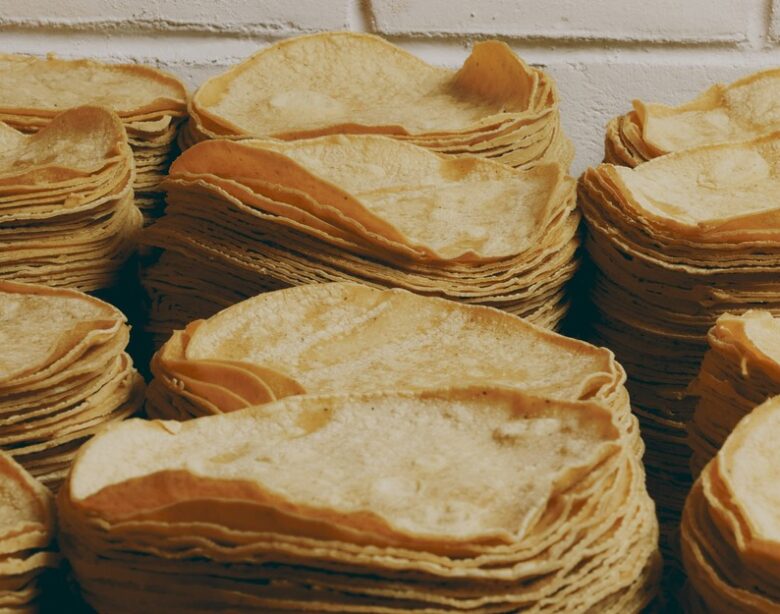[ad_1]
Around midnight every weekday A group of five men and women arrive at the darkened doors of Sobre Masa’s restaurant in Brooklyn and perform the sacred art of transformation. Heirloom corn, which weighs hundreds of pounds in blue, yellow and red, is boiled and soaked for several hours in a lye solution. This is a process called nixtamalization. It’s then washed, ground, air-dried and finally put through a machine that cuts the resulting masa into perfect tortillas and grills them. By 8 a.m., workers have made about 1,000 pounds of masa and… Hundreds of tortillas It smells like popcorn and tastes earthy and ancient.
The tortillas you might buy at the grocery store or even your favorite Mexican restaurant might not inspire the same level of spiritual awakening. Cost and convenience optimizations make the average tortilla more redundant from cardboard than corn. It is not designed for flavor but to encase delicious fillings. But chefs, restaurants and companies Growing hopes to change that. It features a new wave of masa made from single-origin heirloom corn. It revives the sacredness of strong Mexican dishes like tortillas and tamales.
The first time I tasted tortillas really amazed me. I am in Guatemala At a street corner stand by Lake Atitlán, a woman flips through small blue discs. that swelled on the comal She sold it to me in a thick, still delicious pile, packed in a black plastic bag. Eating them is like tasting a special sourdough starter for the first time when all you’ve ever eaten is Wonder Bread Tortillas were an essential part of my diet growing up in Southern California—from the grocery store at my mom’s house. Favorite Mexican MarketAnd sometimes it was also done by my great-grandfather. But as I walked through the market in Santiago Atitlán, I realized what I had been missing out on my whole life.
Modern-day Mexicans began growing corn. 9,000 years ago and discovered nigtamalization a few thousand years later. The modern term for this alchemy descends from the Nahuatl word. next (“ashes”) and watch (“Corn flour”). When simmered in alkaline broth Ordinary corn is especially striking. physical and chemical changes: The outer shell breaks down and the starch turns into a jelly. Not only does it make the seeds taste better and be easier to digest. But it also changes the protein structure. essential nutrients Things like niacin, calcium, and amino acids are easier for the body to absorb. Nixtamalization Turn corn into a cost-effective staple food. Some anthropologists argue that this process helped spur the growth of great Mesoamerican societies such as the Maya and Aztecs. And when tortillas became a mainstay sometime after 300 B.C. Portability has facilitated the growth of a complex and mobile empire. The Aztecs believed that tortillas had spirits. One Maya tribe buried their dead in tortillas. Others believe that the first humans were born from corn flour. from corn masa and from Masa is life

But making masa the old way takes a lot of time. At the turn of the 20th century, enterprising tortilla makers developed a way to make masa more like wheat flour. It is dried and packaged so that tortillas can be made quickly by just adding water. This innovation, called masa harina, eventually helped spread tortillas throughout the United States and around the world. Made especially by Gruma, the world’s largest producer of corn flour (brand name: Maseca) and tortillas (Mission and Guerrero), it also makes most tortillas taste nothing like anything. Purists argue that additional processing results in loss of nutrients. small tortilla maker Filing a doomed antitrust lawsuit resist gruma; Many people go out of business
Because the product of Gruma—rather bland and extremely convenient—spreadtraditional Making tortillas refuse– My great-grandmother was Tex-Mex. And I have good memories. Plenty to eat her buñuelos and tamales. But she barely remembers her tortilla. My mother couldn’t either, probably from Maseca, at least until recently. For many Americans Tortillas made from commodity corn and in many cases also came to Saharina. It’s the only option that’s easily available. Meanwhile There is also a demand for tortillas. blast– one report The value of the U.S. tortilla market in 2023 is $6.7 billion. Last year Gruma alone had net U.S. sales. $3.6 billion–
In fact, the market is so big that artisanal producers are starting to think they can squeeze in too. Sobre Masa, or “about masa” in Spanish, opened in Brooklyn in 2021 and now has a restaurant. About 50 places besides my own and is in the process of expanding branches Small tortilleria in a restaurant Operating in a neighborhood of 5,000 square feet, the restaurant rotates among more than 10 varieties of heirloom corn, much of it sourced from a wholesaler in Mexico called Tamoa. “Our goal is to elevate and bring more awareness to the ingredient. that people don’t necessarily see,” Zack Wangeman, chef-owner of Sobre Masa, told me. In Portland, Oregon, Three Sisters Nixtamal sells fresh local masa and tortillas. and deliver hominy, corn and DIY nixtamalization kits nationwide. Adriana Azcárate-Ferbel One of the founders of Three Sisters told me that she was inspired to start making tortillas because the American product didn’t match the quality of the tortillas she grew up eating in Mexico. According to her, they were missing the “corn spirit” and her mother would bring Mexican tortillas in bags to visit. “I literally keep them in the freezer,” she said.

The star of the artistic masa movement is Masienda. Jorge Gaviria started the company a decade ago with the goal of creating a more classic version of Goya Foods. Masienda started by selling heirloom corn from Mexico to The restaurant and Gaviria had to teach various chef clients how to use the corn. Masienda eventually invented masa harina, and the consumer business took off online in the early days. of the coronavirus pandemic, Whole Foods began selling Masienda’s masa harina nationwide in 2023, and pre-made frozen tortillas debuted this year, Gaviria told me. “We’ve seen a trend over the past few years. that customers are increasingly demanding authentic Mexican food and ingredients; it’s not just about Tex-Mex anymore,” Whole Foods spokesperson Ana Maria Huertas Buitrago told me. Masienda’s masa harina is up 73 percent this year. That compares to the same time last year, she said.
in his book USA tacos, Food journalist Gustavo Arellano writes that tortillas “convey heritage, race, class, and beauty within a circular boundary.” To taste a tortilla made from heirloom corn is to come close to its ancient origins. a little more But that legacy is being marketed. At least now Mainly aimed at economically advantaged shoppers at Whole Foods and diners at upscale Mexican restaurants, Masienda’s masa harina contains infinitely more corn than Maseca. It’s still $12 for 2.2 pounds, compared to $6 for four pounds of Maseca at a Mexican grocery store near me, Spanish. have less income more than other ethnic groups Almost all in the United States– According to the 2023 Census report, Enrique Ochoa, a professor of Latin American studies at Cal State Los Angeles, called that discrepancy a “disparity.” “Fundamental contradiction” The masa revolution is largely priced out of the descendants of those who invented it, but Ochoa tells me it’s also exciting. Tortillas have come a long way from the days of the Spanish conquistadors who considered masa an unhealthy food for the uncivilized and imported wheat instead. (That wheat intended for bread also gives birth to tortillas.) Today, Mexican food, and especially tortillas, are a staple of the American diet. Although Washington actually pursued a policy of keeping out Mexicans, Even if you leave the country
The Masa entrepreneurs I interviewed talked about making Masa a spiritual experience. It is a correspondence with the elders who discovered how to coax incredible flavor and nutritional value from corn. To find my own metaphysical experience I buy dried blue corn and soak it in calcium hydroxide for nine hours until the thick outer husk peels off. small kitchen In my New York area there are no grinders for grinding masa or metates for grinding by hand. So I decided on a food processor. My extra-thick masa turned into tamales. It’s a neat little package that makes my apartment smell like corn while it’s steaming. They were nothing like the tamales I grew up eating. But I still miss you. Reminds me of the times before me. When my ancestors’ tortillas tasted more like corn

[ad_2]
Source link



